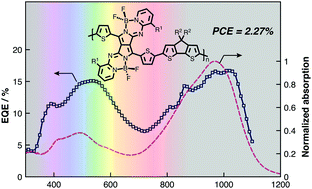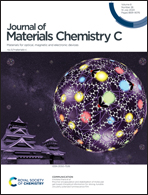Near-infrared absorbing pyrrolopyrrole aza-BODIPY-based donor–acceptor polymers with reasonable photoresponse†
Abstract
Designing near-infrared (NIR) absorbing donor–acceptor (D–A) polymers with photoresponse beyond 900 nm has remained a challenge in the area of organic photovoltaics (OPV) owing to the limited kinds of strong electron acceptors. Here we present the use of pyrrolopyrrole aza-BODIPY (PPAB) as a new acceptor group in D–A polymers in place of a conventional diketopyrrolopyrrole acceptor to achieve power conversion efficiencies up to 2.27% despite the ultra-small bandgap of 1.08 eV. The small photon energy loss of the PPAB-based D–A polymer and moderately high short-circuit current of 8.52 mA cm−2 arising from the panchromatic visible/NIR absorption guarantee PPAB as a potential building block of D–A polymers for NIR photovoltaics.

- This article is part of the themed collection: Journal of Materials Chemistry C Lunar New Year collection 2021


 Please wait while we load your content...
Please wait while we load your content...